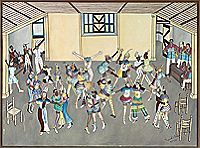
Haitian
Riguad Benoit
Haiti 1911-1986Bal du Carnaval (Carnival Ball) 80.0017
Every year, just before the beginning of Lent, carnival is celebrated in Haiti, just as it is in New Orleans. It is a time when all the rules of behavior and propriety can be broken. The poor can be arrogant and the rich can go slumming. Blacks put on white masks and whites come to dances in blackface. Costumes are daring, elaborate, and often are two costumes in one-male on one side and female on the other. Carnival time is a time when the infamous tricksters of West Africa are about: Anansi, Legba, and Eshu Elegbara. They are forever strolling through the peaceful communities with a hat on that is one color on one side and another on the other side. In the wake of these playful antics, arguments break out as to the description of the stranger who has just passed by. Among other things, carnival time is a ritualized enactment of the relationship between the powerful and the powerless. Benoit's Carnival dance suggests an atmosphere where social class is a major issue. Haiti is the poorest country in the Western Hemisphere and yet 6 to 7 percent of the population is extremely wealthy. Skin color is a class marker-for wealthy mulattoes who align themselves with the French, the lighter the skin, the higher the status. Careful attention to the figures in Benoit's painting suggests that one or two mulattoes have come to the dance.
BACK TO COLLECTION




